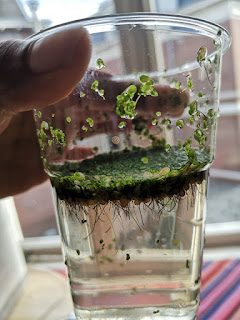Plant Anatomy and morphology
Plant anatomy and morphology
Now I will dive deeper into the anatomy and morphology of the plant. Lemna Minor is a monocot since the plant has no wood stem or root it does not need much support.
Root system
The pant has just one taproot and does not show any signs of branching neither root hairs. The plant's roots are very small (o.5mm) (FAO, n.d.)
In this picture I took you can clearly see that the roots are very small and have no signs of branching.
In this picture I took you can clearly see that the roots are very small and have no signs of branching.
 |
| Picture 2: Self-taken picture |
Growth Habitat
They have a determinate growth habitat. Duckweed lives in water where the temperatures range from 6 to 33 degrees Celcius, warmer temperatures result in a slower growth rate. (Van den Berg Henk, Hak Arne,
& Mooren Caro, 2015)
In addition, the pH must be in a range of 5 to 9. When ammonia contamination is present, the pH becomes higher and this is very toxic for the plant. (FAO, n.d.)
Moreover, the plant needs many nutrients in order to grow, ideally N,P,K. One interesting characteristic of duckweed is that the plant can deal with heavy metal concentrations such as cadmium or chromium. (FAO, n.d.)
Another interesting characteristic f duckweed is that the plant does not remove CO2 from the water but from the air, letting other plants survive and creating a natural balance and clear water. (Schonevijver, n.d.)
 |
| Picture 3:https://gobotany.nativeplanttrust.org/species/lemna/minor/ |
Flowering
Flowers are rare and very small.
Duckweed reproduces asexually, the plants for chains of new stems from vegetative buds. (Fertig Walter, 2013)
The mature frond, also known as the mother can produce daughters from the pockets. The daughters always remain attached to the mother.(FAO, n.d.)
References:
(El-Shafai, El-Gohary, Nasr, van der Steen, & Gijzen, 2007)(Klaus, Nikolai, & Eric, 2013)Appenroth, K.-J., Sree,
K. S., Böhm, V., Hammann, S., Vetter, W., Leiterer, M., & Jahreis, G.
(2017). Nutritional value of duckweeds (Lemnaceae) as human food. Food
Chemistry, 217, 266–273.
https://doi.org/10.1016/j.foodchem.2016.08.116
Van den Berg Henk, Hak
Arne, & Mooren Caro. (2015). Duckweed, a tiny aquatic plant with growing
potential. Retrieved from
https://www.hhdelfland.nl/overheid/onderhoud-aan-water/DuckweedatinyaquaticplantwithgrowingpotentialStudentenUniversiteitvanUtrecht2015.pdf
El-Shafai, S. A.,
El-Gohary, F. A., Nasr, F. A., van der Steen, N. P., & Gijzen, H. J.
(2007). Nutrient recovery from domestic wastewater using a UASB-duckweed ponds
system. Bioresource Technology, 98(4), 798–807. https://doi.org/10.1016/j.biortech.2006.03.011
FAO. (n.d.). DUCKWEED: A
tiny aquatic plant with enormous
potential for agiculture and environment. Retrieved September 20, 2019, from
http://www.fao.org/ag/againfo/resources/documents/DW/Dw2.htm
Fertig Walter. (2013).
Common duckweed. Retrieved September 20, 2019, from
https://www.fs.fed.us/wildflowers/plant-of-the-week/lemna_minor.shtml
Klaus, J. A., Nikolai,
B., & Eric, L. (2013). Telling Duckweed Apart: Genotyping Technologies for
the Lemnaceae. Chinese Journal of Appplied Environmental Biology, 19(1),
1–10. https://doi.org/10.3724/SP.J.1145.2013.00001
Schonevijver. (n.d.).
Floating Plants. Retrieved September 20, 2019, from
https://www.schonevijver.nl/contents/nl/d48_drijfplanten.html



Comments
Post a Comment